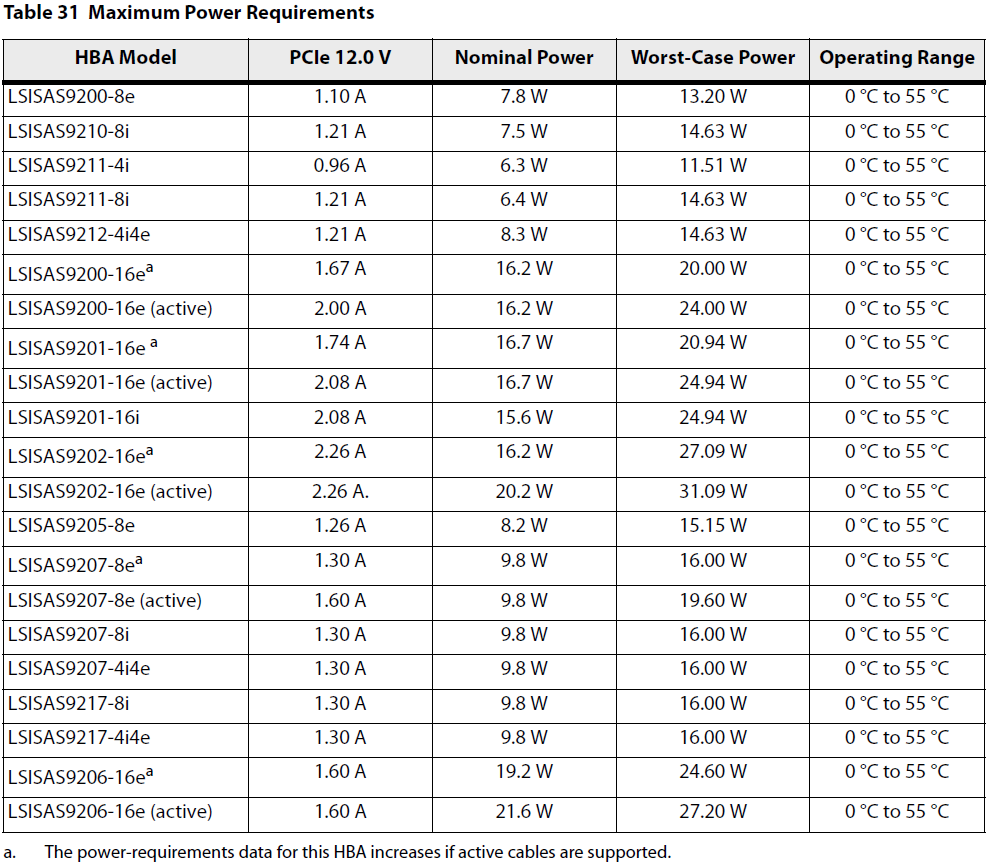In this follow up article on the LSI HBA features comparison we take a look at the power consumption of LSI’s SAS2008 and SAS2308 based HBA controllers. Whether you are building a small business server, colocated server or a simple home server, power consumption is a major focus these days and it helps to know how much an add-in card, such as a LSI HBA, uses. Lower power consumption means lower costs over time.
On the below chart, we are only looking at SAS2008 and SAS2308 based LSI host bus adapter cards and PCI express cards because those are considered current generation. Here is a table comparing the maximum power requirements of LSI host bus adapter cards:

LSI Host Bus Adapter Power Consumption Discussion
Looking at the above PCI Express host bus adapters, the LSI 9200, 921 and 9212 series host bus adapter cards are the least thirsty on 12v power. These are the LSI SAS2008 based cards, and are all very similar. They also are a a good start for a simple small business server with up to 8 drives directly attached. More drives can then be added to the system via a SAS expander or a second card for a low cost but high performance file server with up to 36+ drives. The cards consume between 6.3 to 8.3w nominal and 11.51 and 14.63w max. This is very little considering each HBA can use up to 32TB attached directly using eight of today’s 4TB drives. Of note, the IBM ServeRAID M1015 (part of our popular series that starts here) falls into this category once cross-flashed to LSI 9211-8i firmware. making it ideal for a low power file server that is also very inexpensive to obtain.
The next jump up in power use are the 16 port versions of the above, these use a 16 port SAS controller version of the SAS2008. Double the number of ports means double the nominal power used by the LSI host bus adapter. Interestingly enough, the delta to max power consumption is not that high. This behavior changes with the controllers that can support active cables for longer runs, but not by much.
The LSI SAS2308 range uses more power than its SAS2008 counterpart due to the LSI SAS2308 chip running at a 800Mhz clock speed vs the SAS2008 running at 533Mhz. Simply put faster clock equals higher power consumption and better performance.
The SAS9205-8e being the only SAS2308 PCIe Gen2 card uses a little less power than it’s PCIe Gen3 counter part the SAS9207-8e, another surprise for me.
The LSI SAS 9202 and SAS 9206 use about twice the power of the SAS9200-8e and 9207-8e respectively due to their use of dual controllers on each card. The SAS 9202 uses a little more power due to the use of the PLX8632 bridge, not present on the SAS9206. You can see the LSI 9202-16e tear down and performance figures here.
I hope this short series has been helpful. Feedback is always appreciated.




Isn’t it interesting that HBA power consumption has gotten high enough that it’s a significant percentage of the total power budget for a low-power storage server? My lowest power machine, admittedly not a powerful one, idles at 7 watts and never draws more than 15. Adding a host bus adapter to this little guy would double its power consumption!
I agree with dba.
I think the power consumption is actually very high.
Well, at least if you just run your disk as JBOD and no raid.
Will the SAS2008 also use 6-8watt in idle (no disk activity) ?
I other words, what is the minimum power consumption for the SAS2008?
The SATA controllers on the motherboard use a fraction.
Very nice article – this is an interesting subject.
I just got an SAS-3008 based controller and it run VERY hot….with not disc attached :-(
I will suddenly put more attention on power-consumption for RAID chipset in the future.
It should be possible to low the consumption drastically, but I guess LSI, Adaptec etc. haven’t had much focus on that.